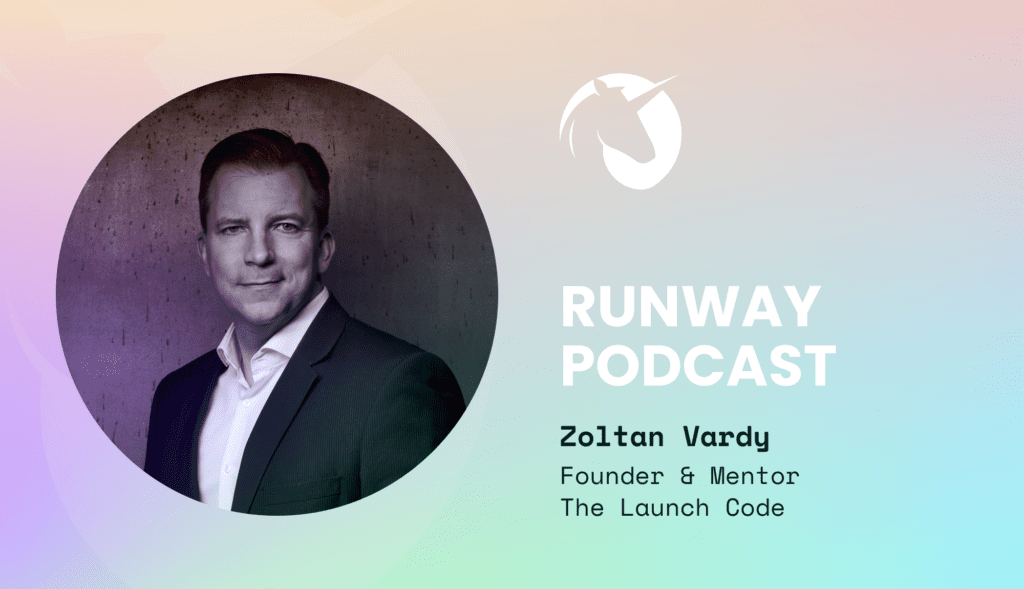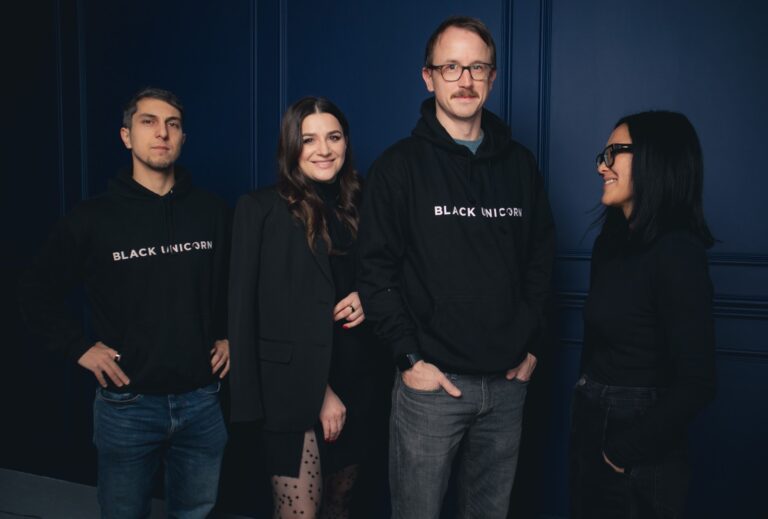In our latest episode of The Runway Podcast, we sat down with Zoltan Vardy, a renowned business growth mentor with a career in sales that spans corporate giants like NBC Universal, but also startups. Zoltan shares insights from his 30-year journey in which he’s closed $2 billion in B2B sales, which he distilled into a set of frameworks and mechanisms to help startup founders.
In the episode, Zoltan shared candidly, offering valuable strategies and guidance for founders navigating enterprise sales. From closing complex deals to building trust and structuring scalable sales strategies, as well as explaining his Launch Code framework, Zoltan dives into actionable steps to help founders grow. Listen in or read the full conversation below!
PS: Zoltan will launch a book with real life examples of applying the Launch Code. It’s coming out in February 2025 and you can sign up here or through the link below to receive the first chapter of the book before it is published. Exciting!
Transcript
Mauro Battellini
Hello, hello, dear friends. Today, we’re excited to welcome Zoltan Vardy to the Runway Pod. Zoltan is a business growth mentor with an impressive track record. He’s closed over $2 billion in B2B sales across his career. We’re going to find out how he’s done that, from major executive roles, including at NBC Universal, to his own companies and startups, to launching the Launch Code. Zoltan is ready to share a wealth of knowledge with us on the topic of B2B sales. Zoltan, it’s good to speak again. Welcome to the pod.
Zoltan Vardy
Thank you very much, Mauro. Great to be with you as well today.
Mauro Battellini
I really wanted to take the opportunity to ask a different set of questions, really brutally, transparently clarifying sales for a new startup founder that has no clue about sales, especially in B2B enterprise sales. Let me start with this one: Your story is that you’ve closed over $2 billion in sales. Can you walk us through what that actually looks like in reality? What kind of companies were you working at when you were closing those deals? What were you selling? Who were your clients?
Zoltan Vardy
Sure. That $2 billion figure reflects a 30-year career in B2B sales, largely in the media industry, where I was responsible for generating advertising revenues for large television broadcasting groups. You mentioned NBC Universal before; I was Senior Vice President of Global Ad Sales there. Before that, I worked for companies like CBS and ProSiebenSat1 Media in Germany as well. I was selling airtime, basically, to advertisers, mostly through media agencies but also through direct relationships with brands. Each of those deals varied—some were smaller, some larger. Perhaps the biggest chunk of that revenue comes from almost a $500 million deal I did with one of the largest advertising agencies in Europe back when I worked for a broadcasting group with 25 TV channels across nine European countries, called SBS Broadcasting. It was a really complex deal, managing the interests of all the local channels and teams while also finding an umbrella agreement that would cover the various brands and advertisers represented by this one agency. It was very complex, took a long time, but it was also very fruitful. It became a game-changer for the company and ultimately led to its exit to another broadcasting group in Germany.
Mauro Battellini
I was going to ask you about the most challenging deal you’ve had in your career, or one of the most challenging, but obviously this one is huge. How long was the process?
Zoltan Vardy
It was probably about nine to ten months, I would imagine. So it was a long time in the works. But that, of course, was a very big deal because of all the different players involved, which made it very complex. Actually, I don’t think it’s the most memorable deal I’ve done, despite the size. The most memorable deal in my professional background is probably one worth 1% of that—around a $50,000 deal. It was a deal I did as an entrepreneur after I had risen to senior sales roles in the TV broadcasting world. I took an off-ramp and launched a .com company focused on building a media-based business in Central and Eastern Europe. One of our early targets was to work with Hewlett Packard, which, at that time, was a leader in digital photography. This was in the late ’90s, so digital photography was a very innovative area. We had to lean heavily on my role as a founder and my approach to a decision-maker at Hewlett Packard. It became a strategic partnership because we were able to become the key partner for this large tech company in digital photography. What I learned is that selling large-value deals is very different when you have a recognizable logo on your business card and the infrastructure of a large company behind you. As a founder, you find yourself selling yourself and the vision of your offering to your customers. That’s challenging but also gratifying, because at the end of the day, they’re not buying your brand logo; they’re buying you and the solution you offer. I always emphasize this in my work with founders who may not be comfortable selling or don’t have much background in sales. This process, if done right, is all about personal success and helping your customers solve their problems, rather than inheriting circumstances you’re in.
Mauro Battellini
Interesting. And also, from a founder perspective, when you’re an established brand, sometimes what you’re offering is already on the shortlist, and they’re choosing between two or three options, and you have to demonstrate you’re the best. Startups, however, often want to disrupt the market, change the world, and they’re selling an entirely new vision. That’s a challenge in itself, right? From getting a foot in the door to persuading or convincing someone to move ahead—it’s a completely different process.
Zoltan Vardy
I compare it to running the 100-meter dash. If you’re in a corporate environment, you start at the 50-meter line. As a startup founder, you’re starting at the negative 50-meter line. It’s a very different race you’re running. But I think the process of ultimately selling to enterprises isn’t magic. There’s no silver bullet that’s going to be the success factor. It’s about consistently following a clear path to getting a yes. That starts with identifying who it is you’re targeting. One of the things I talk about a lot is that not all enterprise customers are created equal. Some companies are more appropriate for startups than others, and certain factors determine that. Then it’s about making sure you’re selling something that matters. If you’re working with an enterprise customer, the effort they put into working with outside suppliers means it has to be something meaningful, something that impacts their bottom line. After that, it’s about getting in front of the right person, making the right impression, and finding the right people and levers to pull to get to a yes. This process requires patience, strategic thinking, and persistence.
Mauro Battellini
You’re clearly passionate about helping startups build that sales infrastructure and take their first steps in enterprise sales, which may be the hardest kind of sales. What drew you initially to the world of startups? What made you decide to dedicate your time to helping early-stage founders?
Zoltan Vardy
My history includes 20 years in the corporate world, rising through the ranks and eventually becoming Senior Vice President of Global Ad Sales for NBC Universal’s International TV networks across 30 countries outside the US. About eight years ago, I left that role with a desire to do something more entrepreneurial. I’d had some experience with startups, including launching a .com under the corporate fold. In this new stage of my career, I started volunteering in various accelerator programs to mentor early-stage businesses. I kept meeting founders who loved their technology and had incredible solutions but no idea how to monetize them. In some cases, they didn’t have the mindset or even believe that selling was essential; it was like, “If I build it, they will come.” I saw all this potential going unrealized, so I started developing a blueprint to address the core issues I noticed. Founders were often missing a focused offer message, lacked a structured approach to client acquisition, and didn’t have a scaling plan. This led to creating what I now call The Launch Code. Since then, I’ve worked with over 200 founders from 26 countries, helping them down a path that, in many cases, has led to tremendous success.
Mauro Battellini
Impressive. Can we break down The Launch Code and look at it piece by piece? But before that, I also wanted to ask about an even earlier stage. Suppose a founder hasn’t raised a seed round yet. Where should they start when they need to begin thinking about sales? They’ve seen a pain point in the market and validated the problem, but how should they think about monetizing?
Zoltan Vardy
Great question. I’d break it down into two parts: mindset and practical skills. First, there’s the mindset part, which I can’t overemphasize. As a founder, you have to experience the process of going out to customers, explaining the problem you solve, how you solve it, why you’re better than the competition, and using feedback to iterate your product. Many founders believe they can avoid sales by leaning on a sales team, but you can’t. You need to create that problem-solution connection, which is fundamental to successful selling. Then, there’s the practical part: the actions to take for successful selling. For example, you need to clearly communicate your value. Often, founders assume people understand their product, but that’s naive. At events, when asked, “What does your business do?” they’ll go into complex, jargon-filled monologues. Step one is to be able to communicate that value in a simple, clear sentence. Then, understand that your ability to sell will depend on who you’re speaking to. Identify your ideal customer—the one who sees your solution as perfect for their problem—and use a combination of outbound sales, partnerships, and inbound marketing to reach them. These are the fundamentals. Once you have those in place, you can talk about scaling and delegating sales responsibilities.
Mauro Battellini
With the founders you’re advising, how do you find they get their foot in the door at first?
Zoltan Vardy
There are normally two strategies founders follow, and they often pivot from these. The first is, “I know a guy.” They’ll rely on a small network—maybe a friend or family member with a connection—and hope that will secure their first deal. While that can work for a couple of deals, it’s unlikely to result in ideal customers or scale. The second approach is “spray and pray.” This is when founders send out 1,000 emails and hope someone responds. There are AI tools and targeting tools today that make this more efficient, but I’m skeptical, especially in enterprise sales, where cold outreach rarely works. The alternative approach is to first clearly identify who you want to speak to. Define your ideal customer by industry, revenue, team size, and specific characteristics. Then, within those companies, identify the decision-maker—maybe the head of logistics, finance, or another relevant department. Once you have a list of 50 to 100 companies that fit your profile, start researching how to get in front of them.
For example, I reached out to Joe De Sena, the founder of Spartan Race, by leveraging our shared alma mater, Cornell University. I simply wrote, “Fellow Cornellian—invitation to speak on my podcast” in the subject line. He responded in seven minutes, and I had him on my podcast a week later. This is what I call finding a touchpoint. Getting into someone’s sphere of comfort by making a genuine connection can make all the difference in securing a meaningful conversation.
Mauro Battellini
For a startup from Europe looking to acquire US clients, what about events? I see more European founders attending US events. Are events valuable for meeting enterprise B2B clients?
Zoltan Vardy
Events are critical for enterprise sales and should be part of your inbound marketing strategy. The level of presence you need depends on your resources. At the very least, you should attend relevant events and use the attendee app or website to see who’s going, then set up meetings in advance. If you can secure a speaking spot, it’s even better for credibility. The ultimate level is exhibiting at the event. The advantage of events is that everyone there is interested in networking and selling, so that initial resistance you might face with cold outreach is gone. Follow-up is equally important. Connect on LinkedIn within 24 hours, and if you see potential, set up a follow-up meeting in a formal setting.
Mauro Battellini
Creating that warm touchpoint is crucial. Aside from events and content marketing, what else can a founder do to foster more warm connections?
Zoltan Vardy
Events and content marketing are two effective ways, but you can also tap into smaller meetups or industry-specific gatherings. The key here is to put yourself out there. Don’t just attend these gatherings; actually engage, introduce yourself, and meet people. Content creation is another touchpoint. LinkedIn, for instance, is essential in B2B sales. The average B2B sales process takes 11 months, and potential clients will research your company long before they reach out. You want them to find content that builds credibility. Posting regularly on LinkedIn allows potential clients to engage with your content, which can then become a reason to connect. This creates an opportunity to reach out and start a meaningful conversation.
Mauro Battellini
Should founders seek out VCs who can facilitate customer introductions, or is that rare?
Zoltan Vardy
Many VCs market themselves as more than just a source of capital, offering knowledge, contacts, and expertise. Some live up to that; others may not. Ideally, VC introductions should be one of many sources for potential leads, but it shouldn’t be the only strategy. I’ve personally facilitated introductions for companies I’ve invested in, like Intavo, where I connected them to relevant contacts. However, these introductions are a nice bonus, not a sustainable sales channel.
Mauro Battellini
Going back to a founder closing their first deal, what can they expect in the process?
Zoltan Vardy
It’s likely going to take longer and be harder than they expect. I’d break it down into key steps. First, identify your ideal customer and narrow your focus to people likely to be interested. Then, get in front of the right person. After that, use the discovery call to confirm alignment. In a 30-minute call, spend the first 20-25 minutes asking questions and presenting your solution, then leave five minutes to gauge interest and agree on next steps. At the end of the call, schedule a follow-up meeting to maintain momentum. Over the course of the sales process, your goal is to keep the conversation moving forward by setting follow-up actions at every touchpoint. I always emphasize deal momentum: keep things moving. Sometimes a quick “no” is better than being stuck in a “maybe” loop.
Mauro Battellini
Forget about small deals—let’s talk about the big ones. Do you find that discovery calls typically start with those feeling the most pain, and then you work your way up to the decision-maker?
Zoltan Vardy
The start of the process is understanding their pain. You need to know if the solution you’re offering is relevant to them. If you’re pitching a solution to improve employee communication, but the person you’re talking to believes employee communication in their company is perfect, it doesn’t matter if your solution is great. If there’s no pain, there’s no sale. The trick is to identify whether the pain point is a “shark bite” or a “mosquito bite”—whether it’s something they feel they need to address immediately. You also want to make sure they have the urgency and budget to make a decision. Often, sales is about filtering out those who don’t fit these criteria so you can focus on those who do.
Mauro Battellini
Even if you’re tempted to go directly to the decision-maker, if they aren’t the ones feeling the pain, it’s better to start with the champion, right?
Zoltan Vardy
Absolutely. In large organizations, decisions are often made by committee, so having a champion who understands the problem and wants your solution is essential. This champion is usually someone one level below the decision-maker who has a vested interest in the solution. For example, if your solution benefits the sales team, the sales director might be your champion, even if they don’t have the budget authority. Your goal is to develop a relationship with this champion so that you’re ultimately able to present your case directly to the decision-maker.
Mauro Battellini
Let’s say the startup is growing, the founder has closed a few deals, and now they’re overwhelmed. Where should they start delegating? When is the right time to bring in sales support?
Zoltan Vardy
This is a tricky stage. Up until now, the founder has likely been the driving force behind every sale, often without realizing that much of the success comes from their personal passion and commitment. When they reach the point where they can’t handle everything, it’s time to build a structure underneath them. Start with an SDR (Sales Development Representative) to handle lead generation and some administrative support to manage presentations and invoicing. You may also bring on an account manager to nurture leads and move prospects toward closing. In terms of marketing, someone who can handle content and social presence is beneficial, possibly alongside a PR agency to build external visibility. But even with support, the founder should still be directly involved in revenue generation until the team is fully capable.
Mauro Battellini
A lot of founders make the mistake of hiring someone from a large company who might not fit a startup environment. How do you prevent that?
Zoltan Vardy
This is a common pitfall. Founders often hire based on the CV rather than attitude. While experience matters, you need someone who’s comfortable in an unstructured, chaotic environment and is willing to build processes from scratch. You don’t want someone who expects the brand, processes, and infrastructure to be in place, as in a large corporation. In a startup, you need someone with the right attitude who is flexible and can create the structure needed for a growing sales organization.
Mauro Battellini
I guess this is where The Launch Code comes in. How do you usually apply it depending on the company’s stage or traction? Are there common weaknesses you see across organizations?
Zoltan Vardy
I work with a specific type of business—tech or tech-enabled B2B companies where the founder is still in charge of sales and marketing and needs to establish recurring revenue. The Launch Code provides a structured approach to solve three core problems.
The first pillar is creating a focused offer, so customers understand what they’re buying. This involves clarifying your value proposition in a single sentence, outlining your product offering, and creating messaging that leads potential customers to ask, “How can you help me solve my problem?” This message should be applied across all sales and marketing materials, like your website, pitch deck, and one-pager.
The second pillar is customer acquisition. I believe it’s better to have a high conversion rate with a focused audience than casting a wide net. You do this by using outbound sales, partnerships with third parties who provide credibility and reach, and inbound marketing to create interest. This balanced approach enables you to acquire customers in a sustainable way.
The final pillar is creating scalable operations so the founder can eventually step back and focus on strategy. This involves setting goals, tracking KPIs, and creating systems to check progress. Eventually, you’ll build a team to execute on sales, but The Launch Code provides the foundation needed to get there.
Mauro Battellini
How can people find out more about The Launch Code? Any events or speaking engagements coming up?
Zoltan Vardy
I’m very active on LinkedIn, so people can follow me there. My website, zoltanvardy.com, has details on The Launch Code and upcoming speaking engagements. I’m also working on a book that covers The Launch Code with specific examples and stories from over 200 founders I’ve worked with. If anyone’s interested, they can go to zoltanvardy.com/book to sign up for the first chapter, which will be available before the book’s launch next February.
Mauro Battellini
Zoltan, thank you so much for sharing your insights—a sneak preview of The Launch Code. Thanks for being here.
Zoltan Vardy
It was great to be here, Mauro, and I hope your listeners find this conversation as useful as I did.
Mauro Battellini
Thank you, Zoltan. Bye.
Can’t get enough of the Runway pod? Check out these other episodes:
Stories of Founding, Investing, Exiting with Alex Gibb
When Comms Meets Venture Capital, with Elisheva Marcus, VP Comms at Earlybird VC
Matthew Thompson, Director Sales Development EMEA at Deel: Running and Scaling Inbound Sales
Eric Melchor, founder of B2B PodPros on running and advertising on podcasts
The Ins and Outs of LinkedIn for Startups with Kotryna Kurt
Affiliate Marketing 101 with Vik Ratomske of Partnergap
Adam Jennings on the foundations of branding
Silicon Valley veteran Gregory Kennedy on B2B startup marketing
Robin Wauters on European tech, the business of media and AI
Ex-Fortune editor Jake Meth on planning, writing and pitching the perfect op-ed



